Tender and cakey these easy Sourdough Discard Scones are a delicious hearty treat. Butter and sourdough discard impart a rich flavor that makes these scones delicious on their own or slathered with butter and homemade raspberry preserves. This 1-hour simple scone recipe is easy to make with no special equipment needed.
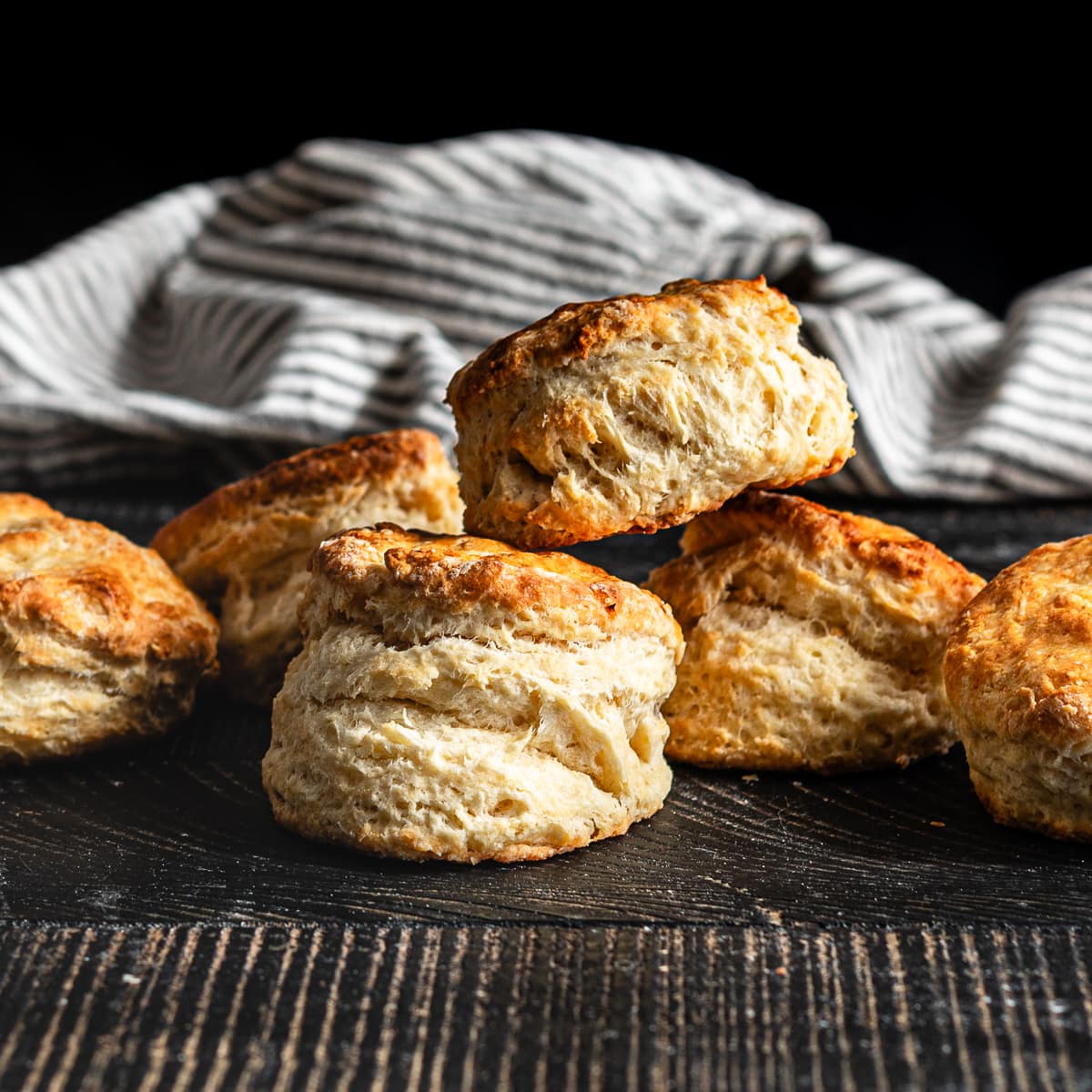
Jump to:
What is a scone?
Scones are a type of quick bread leavened with baking soda or powder, not yeast or sourdough starter.
The addition of an egg makes scones different from biscuits, resulting in a crumbly, tender crumb as opposed to a flaky, layered crumb. Unlike my favorite sourdough biscuit recipe, which involves a simple lamination method, these delicious scones come together easily with a finer, cake-like crumb.
What's the difference between scones and biscuits?
Biscuits and scones are both quick breads. Scone recipes usually include eggs and other add-ins such as dried or fresh fruits while biscuits do not.
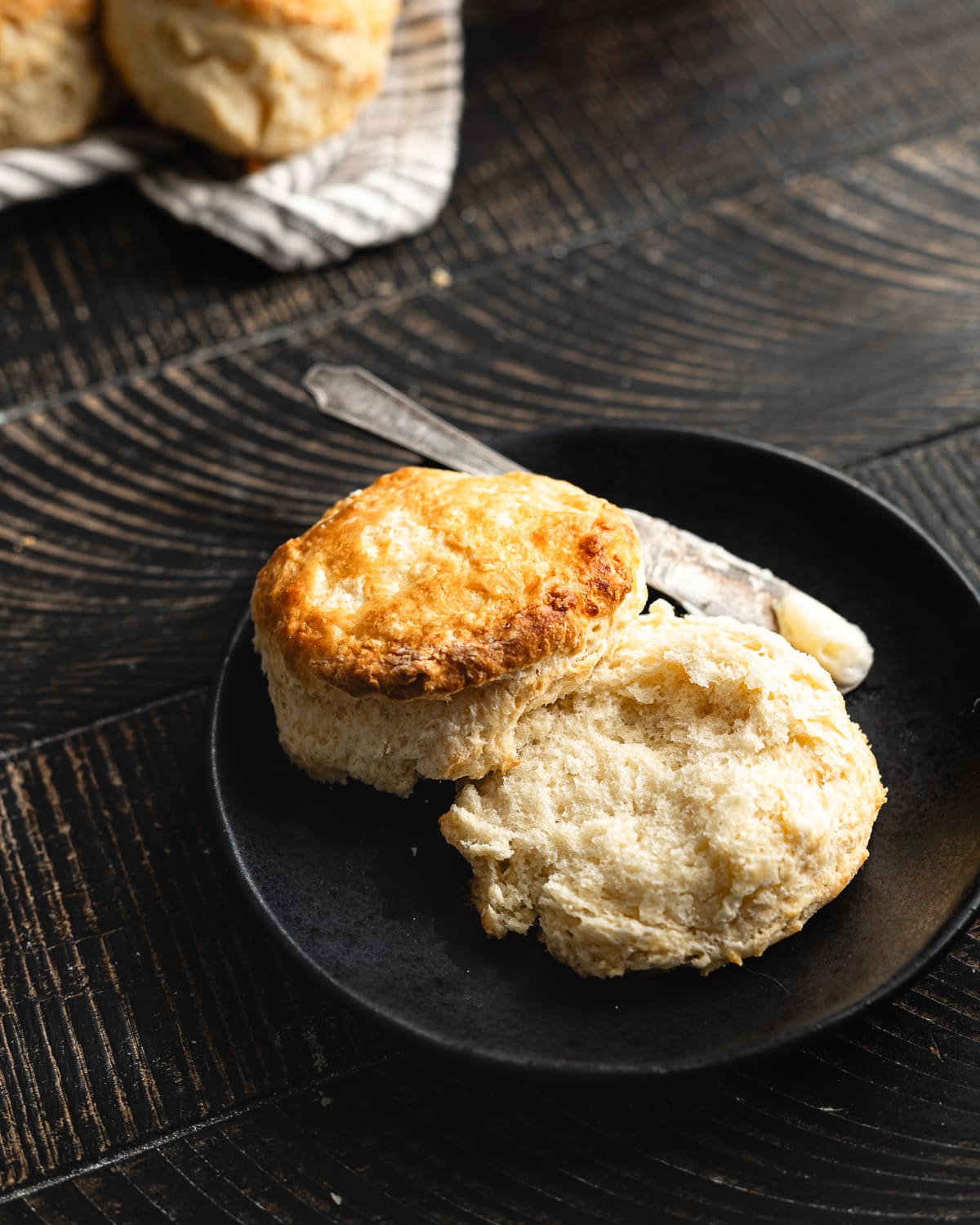
Very yummy scones produced, crispy on the outside and cakey (which I always wanted but never had achieved in the past 👍🏻) in the middle... they were delish even without butter 😋.
- Peg
Sourdough discard quick breads
If you’ve been following the blog for a while, you’re probably already familiar with my obsession with sourdough quick breads. I love having recipes like my Sourdough Discard Biscuits, and my Cream Cheese Biscuits from my book Sourdough Every Day, in my back pocket for times when I'm short on time and want to serve fresh baked goods but don't have time to prepare a Homemade Sourdough Bread.
These Sourdough Scones fit right into the category and are perfect for when I want a more cakey and tender breakfast treat.
If you love easy quick breads, try my Sourdough Discard Soda Bread, Sourdough Guinness Brown Bread and Sourdough Butter Swim Biscuits.
What you need
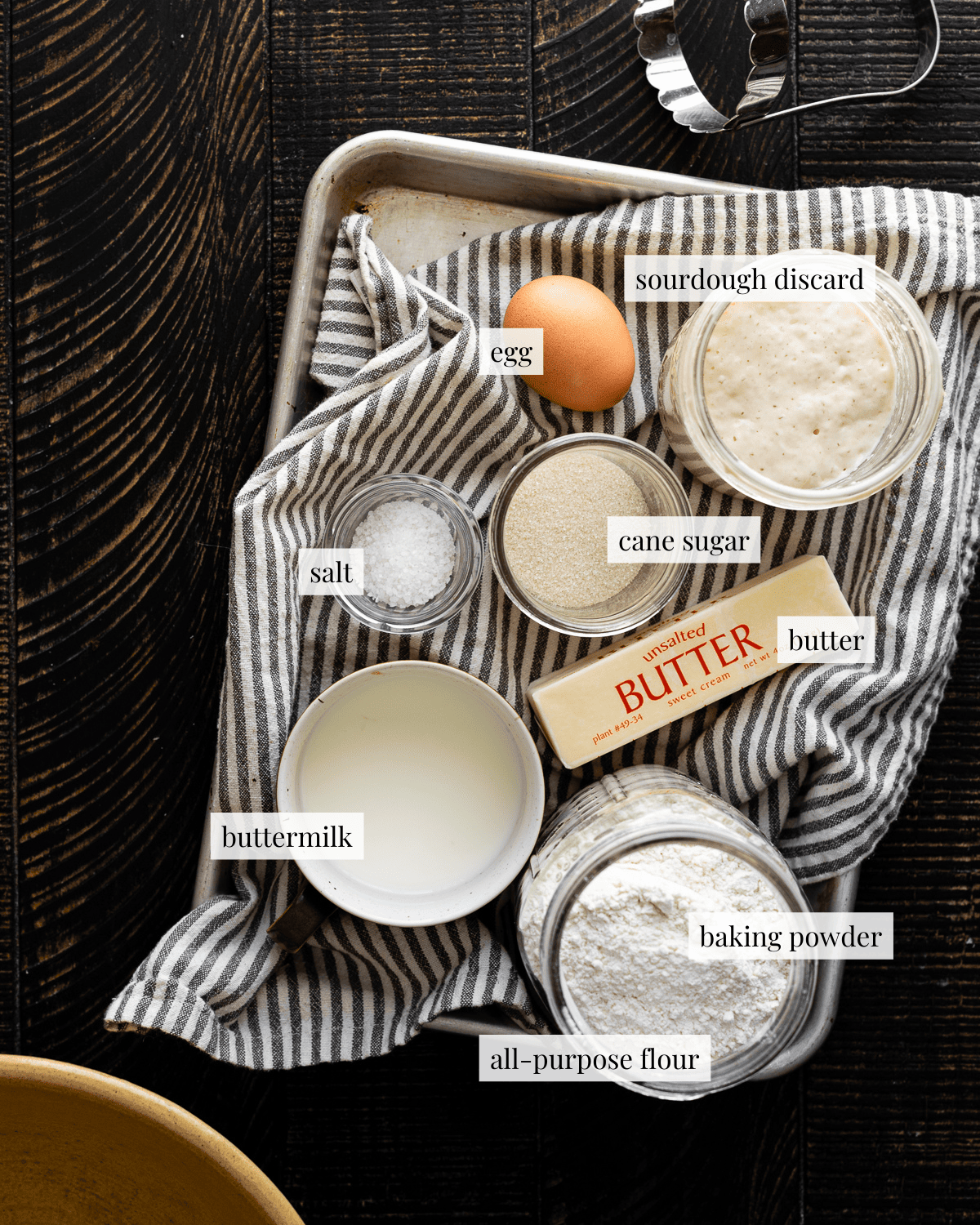
Buttermilk: Store bought or homemade buttermilk will both work for this recipe. Substitute whole milk with ¼ teaspoon of apple cider vinegar or lemon juice. You can use excess buttermilk to make Sourdough Buttermilk Pancakes, Sourdough Discard Biscuits and Sourdough Discard Blueberry Muffins.
Sourdough discard: Sourdough discard adds a delicious tang to these scones. If you don’t have any extra sourdough discard, you can substitute active starter or add 56 grams of water and 56 grams of all-purpose flour into your dough.
Salt: Use sea salt or kosher salt for the best results. You may need to adjust your measurements if you use teaspoons, but the gram measures will be the same.
Tip
Keep your ingredients and dough cold so that the butter doesn’t melt before the scones are baked.
Baking with discard starter
Quick breads use chemical leaveners to get their rise, in this recipe we'll be using baking powder to achieve the fluffy, tender texture that we want. Adding sourdough discard adds a great tang to these scones and in the case of this recipe, we'll only be using it for flavor. Since you are not using it as the main leavener, your sourdough starter does not need to be activated or fed and can be used straight from the fridge.
Your discard will affect the flavor of your scones. If you’re using sourdough that’s been in the fridge for weeks it will add more acidity, which you won’t get when using a freshly fed starter. Both will work for this recipe but you’ll get different results.
Add-ins
This is a basic scone recipe without any fillings or add-ins. I took inspiration for this recipe from Irish Scones, which are traditionally made plain or with dried currants.
They serve as a blank canvas for delicious toppings like cream, homemade blueberry preserves and butter (maybe all three). You can even slather them in homemade honey butter for an extra special treat.
It's best not to add fresh fruits like berries to this recipe as it would made the dough too wet and will negatively affect the texture of the scones and make them spread.
Here are some yummy ways to add flavor to these scones:
- Citrus zest (lemon, orange or lime)
- Spices (cardamom, cinnamon, etc)
- Herbs (rosemary, thyme, sage, oregano)
- Dried fruit (cranberries, blueberries, raisins)
- Chocolate chips
Try my recipes for Pumpkin Sourdough Scones and Sourdough Cranberry Orange Scones.
Step-by-step Guide
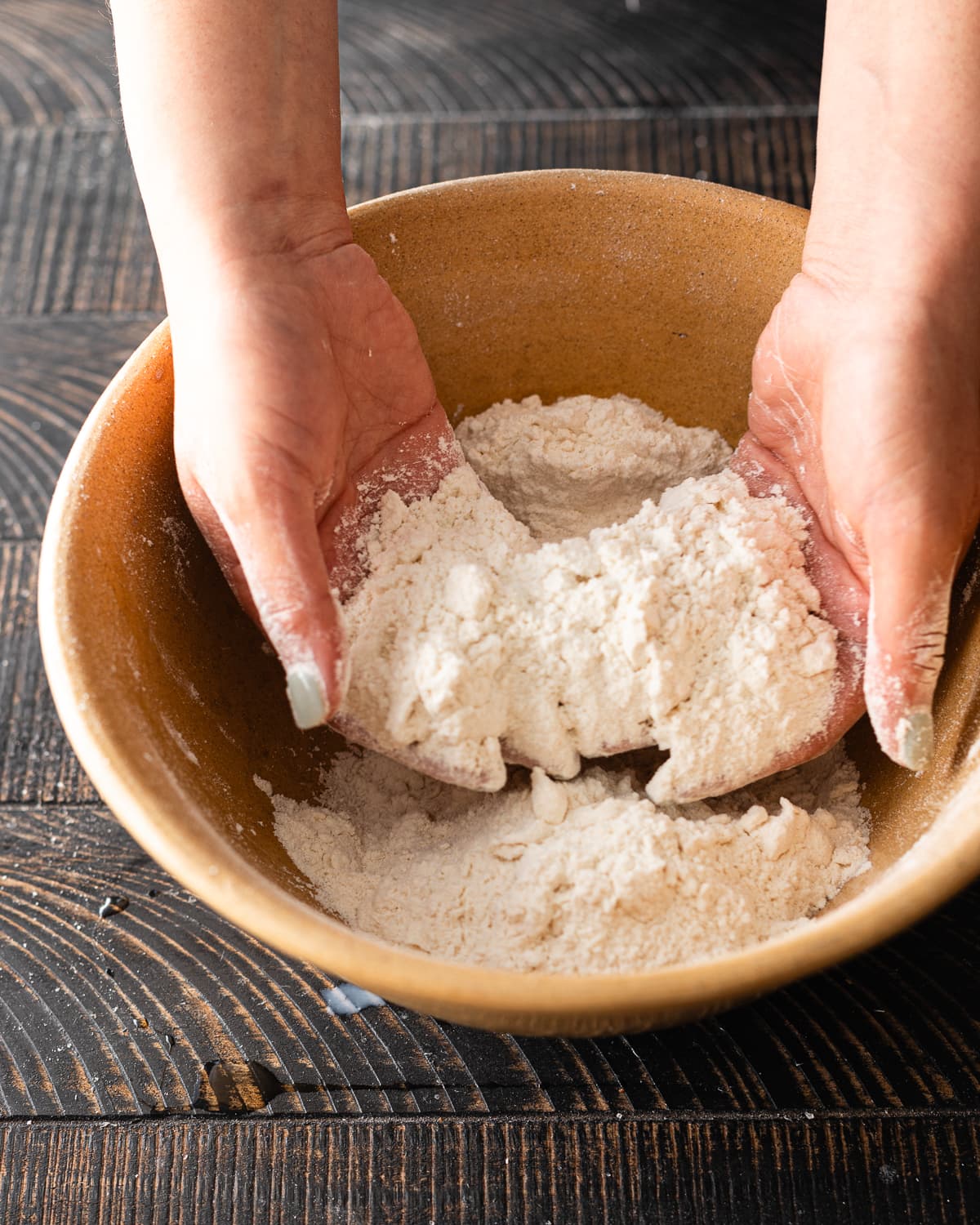
STEP 1: Mix the dry ingredients and rub the butter into the mixture until coarse crumbs form. Add in the wet ingredients and knead the dough lightly.
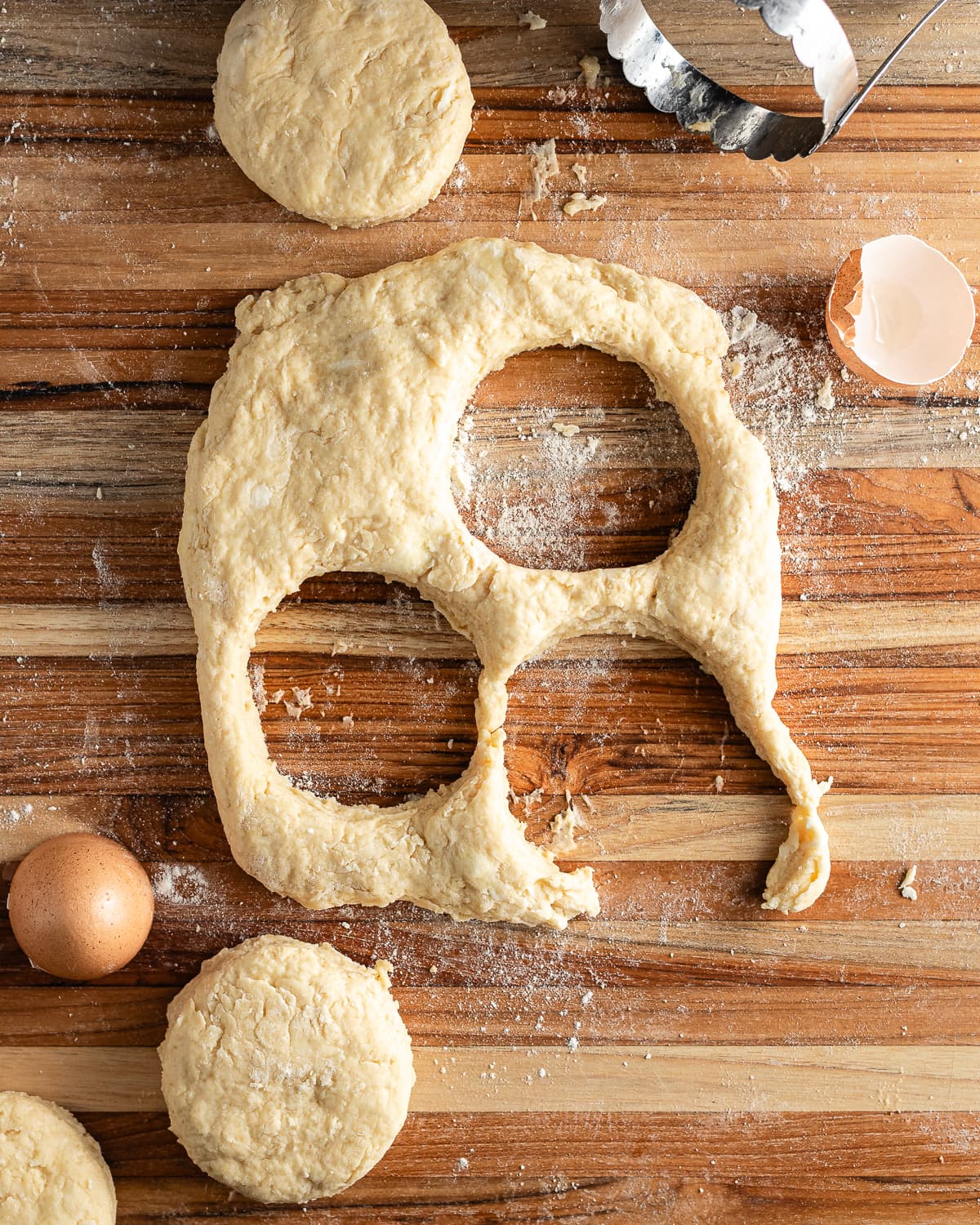
STEP 2: Flatten the dough out into rectangle roughly 1-inch thick, use a 3-inch biscuit cutter to cut out your scones.
Tip
The crucial factor for excellent scones lies in achieving just the right level of gluten development. Knead the dough until no dry pockets of flour remain this will prevent your scones from tasting dry and crumbly. However, be cautious not to overwork the dough, as this can make them dense and gummy.

STEP 3: Place scones on a parchment-lined baking sheet and glaze with excess milk and egg mixture.

STEP 4: Bake at 425 F for 10 minutes, turn down heat to 325 F and bake for another 10 minutes or until evenly browned.
Tip
High oven temperatures causes the water locked in butter to turn into steam as the scones bake. This creates steam and pockets of air in the dough leading to soft, tall, tender scones.
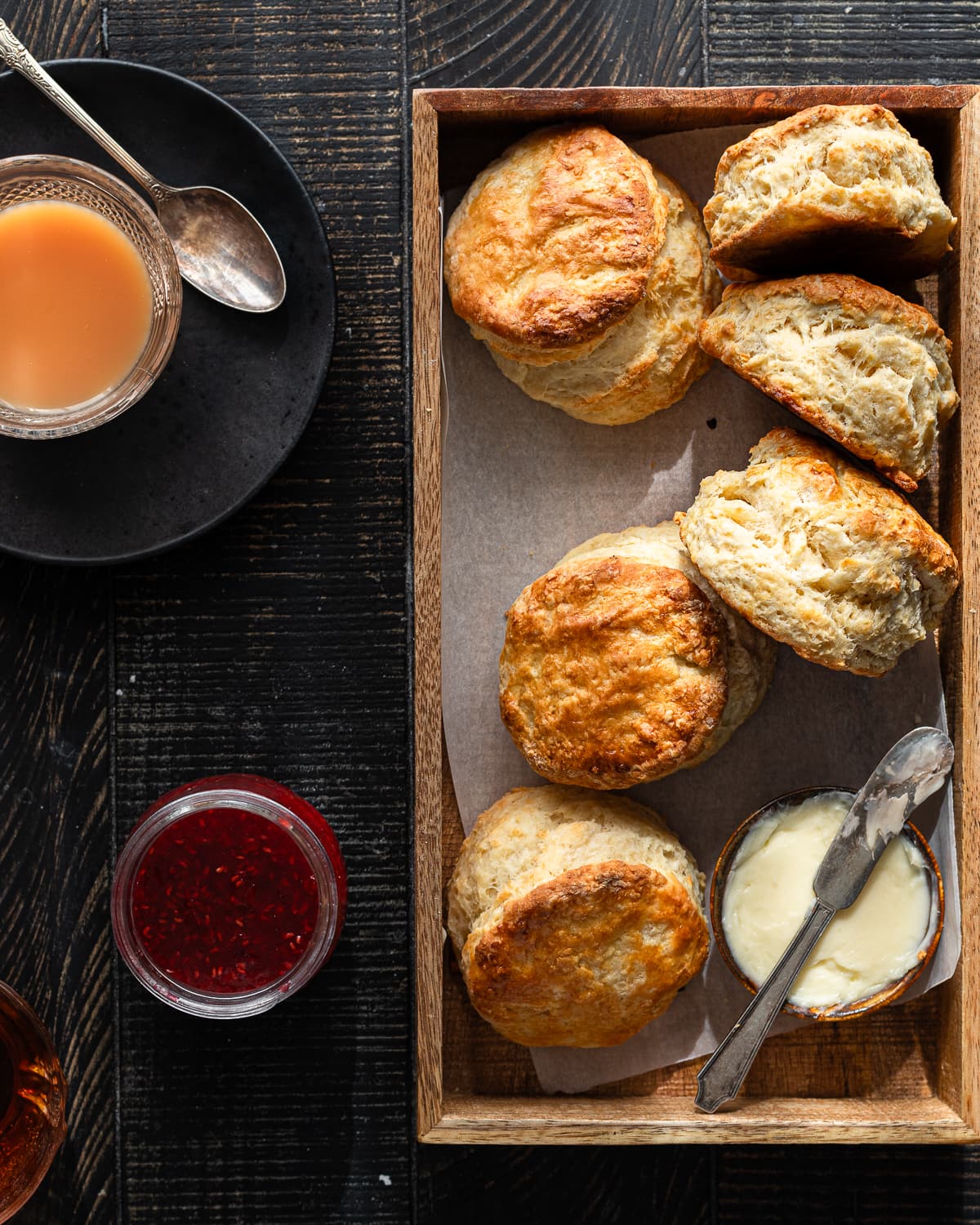
Baker's Tips
- Weigh your ingredients instead of measuring by volume (tablespoons and cups), it’s more accurate and will help guarantee the success of your bake.
- Make sure your baking powder is still fresh and active before making this recipe, chemical leaveners have a limited shelf life if your baking powder is expired it will not help your scones rise.
- Use buttermilk, it's a byproduct of the butter-making process, is naturally acidic and reacts with baking powder to help scones rise higher resulting in softer scones that rise higher.
- Use high-quality butter. These scones are all about the butter flavor, so splurge on European butter (which has a higher % of fat) or organic grass-fed butter which has a better flavor.
- Use a light-colored baking sheet. A dark baking sheet will get too hot and may cause the bottom of your scones to burn.
Make ahead instructions
Once you make the dough, it can be frozen for longer term storage.
To freeze your scone dough:
- Cut out your scone portions.
- Arrange the scones side-by-side in a single layer on a parchment-lined baking sheet (no need to space them out)
- Freeze the tray uncovered for at least 1 hour.
- Transfer the frozen dough to an airtight container or a freezer bag.
- Store in the freezer for up to 3 months.
To bake frozen scones:
- Preheat the oven to 375 F.
- Arrange biscuits at least 1-inch apart on a baking sheet lined with parchment paper.
- Brush the top of the dough with melted butter and milk (or buttermilk).
- Bake the biscuits for 30 to 35 minutes or until golden brown.
Recipe FAQs
Your leaveners may be past their prime. Baking soda and baking powder have a shelf life and after a point are no longer viable. Test your leaveners by combining a teaspoon with a drop of vinegar, if it fizzes it's still good and you can still use it. If it does not it will no longer make your bread rise and it should be thrown away.
You may have not kneaded your dough enough and you may have left some dry patches of flour in your dough. Without overworking your dough, knead it lightly just until all of the flour is hydrated.
No, biological leaveners such as sourdough starters require a combination of time and gluten development to make baked goods rise. As yeast ferments, it releases CO2 which gets trapped by strong gluten networks in the dough. Gluten development will negatively affect the texture of your scones.
Absolutely! Simply use the same proportion of freshly fed sourdough starter in the recipe. Your starter won’t add a strong tangy flavor to your scones, but will still work.
If you don’t have a starter, but still want to try out this recipe, simply add 56 grams of all-purpose flour and 56 grams of water to your dough.
You may also like
Did this recipe rise to the occasion?
★★★★★
Please leave a star rating and a comment. Your feedback helps me create more delicious sourdough recipes. I read and truly appreciate every message.
Don't forget to PIN this recipe on Pinterest to save it for later!
Thank you for your support!
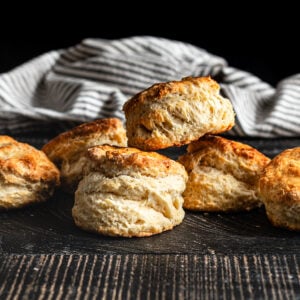
Sourdough Scone Recipe
Equipment
This section may contain affiliate links
Ingredients
- 150 g buttermilk
- 1 egg large
- 113 g sourdough discard
- 300 g all-purpose flour
- 14 g baking powder
- 3 grams kosher salt
- 30 grams granulated sugar
- 56 grams unsalted butter frozen and cubed
Click US Customary to view volume measurements
Instructions
- Prep: Preheat your oven to 425 F (220 C). Line a 18 by 13 inch baking sheet with parchment paper, and set aside.
- Make the scone dough: Whisk together the egg and milk in a large glass measuring cup, until completely combined. Set aside 3 tablespoons of the mixture (for glazing your scones).150 g buttermilk, 1 egg
- Add the sourdough discard into the egg mixture and stir until no traces of sourdough remain. Set mixture aside.113 g sourdough discard
- In a large mixing bowl, whisk together flour, baking powder, salt and sugar.300 g all-purpose flour, 14 g baking powder, 3 grams kosher salt, 30 grams granulated sugar
- Rub the butter in by hand or with a pastry cutter until the mixture resembles fine breadcrumbs.56 grams unsalted butter
- Make a well in the center of the flour mixture, and pour in half of the milk mixture. With a large open hand gently mix the ingredients together until a shaggy dough forms. Add the remaining milk mixture and incorporate any leftover dry bits of flour.
- Knead: Turn the dough out onto a clean surface and fold the dough on itself 4 or 5 times or until no traces of dry flour remain. Use a light hand and don't overwork the dough, but make sure the dough is cohesive and well incorporated and not crumbly.
- Shape: Turn the dough out on a lightly floured work surface. Using your hands, flatten the dough out into an 8-by-10 inch rectangle, about 1 inch thick (the size doesn't have to be exact).
- Using a 3-inch biscuit cutter, cut 6 scones and transfer them to prepared baking sheet.
- Re-roll the dough lightly and cut 2 more scones. Transfer the dough to the baking sheet.
- Bake: Brush the top of the scones with reserved milk and egg mixture.
- Bake scones for 10 minutes at 425 F (220 C) and then reduce oven temperature to 325 F (160 C) for another 10 to 15 minutes or until the scones are golden brown. Don’t over bake or your scones will turn out too tough and crusty.
- Take scones out of the oven and place on a wire rack to cool.
- Enjoy and store: Eat warm, filled with jam, butter or cream.
- These delicious sourdough scones are best eaten the day they are baked, but leftover scones keep well in an airtight container at room temperature for up to 2 days.
Tips
These recipes were developed and tested using grams for precise measurements. To increase your chances of success, I recommend investing in a kitchen scale. I've included rough volume estimates (in tablespoons and cups), but they might not be totally accurate.
Remember all ovens are unique, these recipes were tested in my oven which runs cooler than others. You might need to lower the temperature if your bake appears to be browning too quickly. Monitor your bake closely and make adjustments if needed.
Notes
- Make sure you use a light hand when making these scones and avoid overworking the gluten or your end result will be tough and dry.
- These are best enjoyed the day they are baked, but will keep well in an airtight container for up to 2 days.
- Buttermilk results in fluffier scones, substitute whole milk with ¼ teaspoon apple cider vinegar or lemon juice.
Nutrition
I am not a nutritionist or dietitian, any nutrition information provided is an estimate.

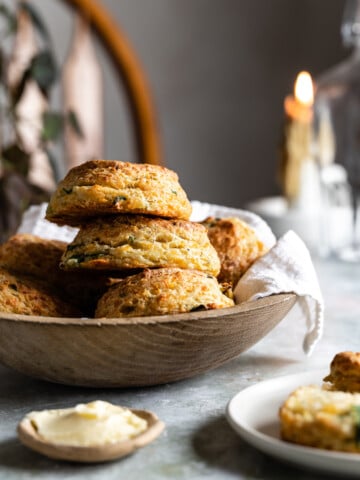



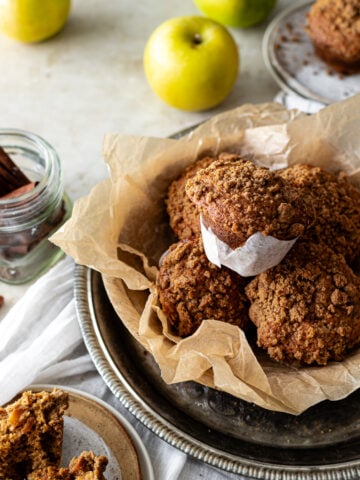
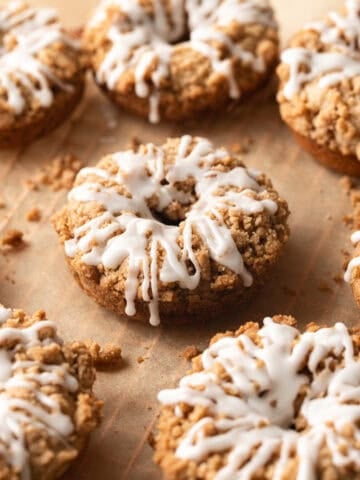
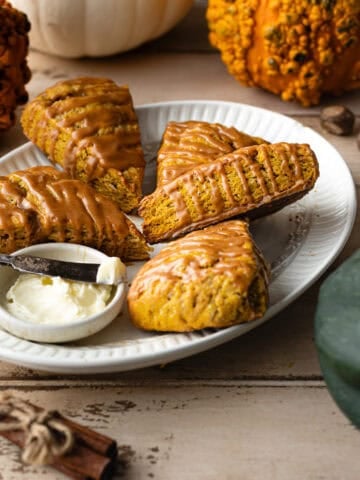
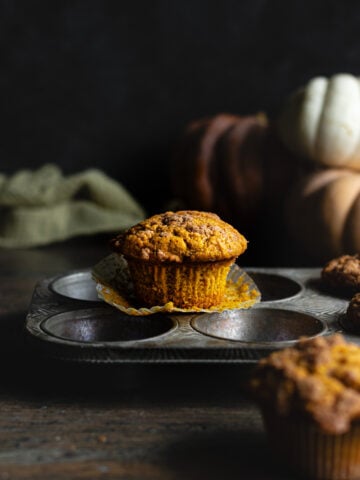

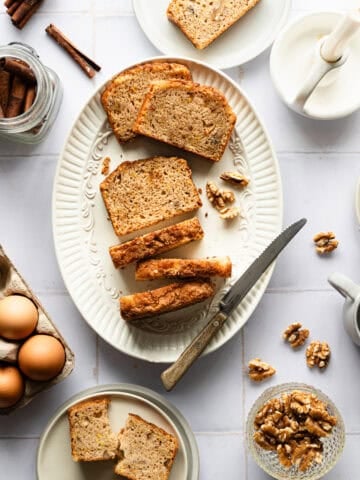
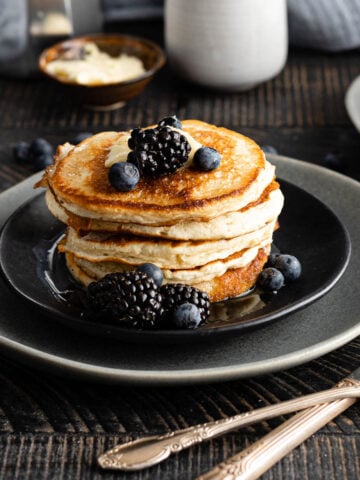
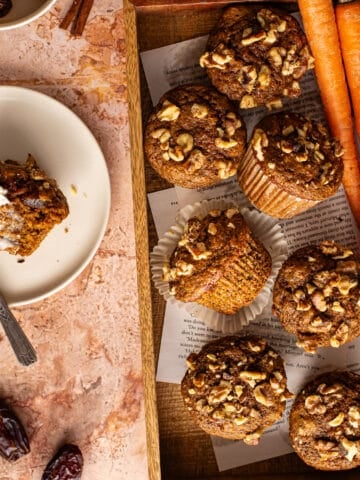
Kirsty Moore says
Wonderful scones! Thank you for the recipe. I was quite true to your ingredients but was a tiny bit short of baking powder and didn't have any buttermilk, vinegar or lemon juice (we are on holiday, so don't have a full pantry). I added just a few grams of baking soda instead 🤷🏻♀️
I also froze my butter in one block by mistake, and then couldn't cut it into cubes, so just grated it in instead.
Mine were cooked in 22 mins (internal temperature around 92C).
They were very well risen, slightly crispy on the outside, soft and fluffy on the inside and really tasty. Not too crumbly either.
Definitely a keeper!
Hannah Dela Cruz says
I am so thrilled you loved them and they worked with the ingredients you had on hand.
Anne says
So easy and delicious. I forgot to reserve the 3 Tablespoons of egg and milk before adding my starter—-oops. Just used a bit extra flour on the table when kneading and patting into shape. I also added finely chopped preserved lemon. They were fabulous! Rose beautifully and the taste is outstanding. Will definitely be making these again.
Hannah Dela Cruz says
That sounds delicious!
Rashida says
Tripled the recipe to use up all my discard; they look great, havent tasted them yet. Can I freeze them?
Hannah Dela Cruz says
I've never frozen baked scones. But I always freeze the unbaked dough to enjoy later.
Peg says
Thanks Hannah. Very yummy scones produced, crispy on the outside and cakey (which I always wanted but never had achieved in the past 👍🏻) in the middle. I made my own buttermilk using standard milk and apple cider vinegar. Also, I used 60gm wholemeal flour and 240 gm all purpose flour and added jujube, dates, raisins and homemade peels and they were delish even without butter 😋
Hannah Dela Cruz says
Wow! Those sound like excellent additions. I'm working on a version of this scone recipe with add-ins as well. Stay tuned!
Peg says
Made a different batch for lunch today. This time, I made double, ie 600gm of flour and added chives, tasty and edam cheese and ham (all little cubes); tried my luck using 400 gm wholemeal and 200 gm all purpose. Sieved the flour and sprinkled back the bran and then added the cheese, ham and chives. With large open hand gently incorporated them. After all ingredients (including the liquid) were added to flour mixture, I turned them out onto bench without kneading as was cautious the wholemeal flour might toughen scones if overmixed. Cut them into 20 pieces (2 trays) and fan baked in a 200 deg C preheated oven for 22 minutes (half way through swap tray position). Happy with the outcome again; crispy on the outside and cakey in the middle and the flavour was delish. Left some out for lunch tomorrow and freezing the rest when they have cooled down. Turned out alright those first batch of frozen scones when reheated in my Whirlpool microwave oven using the crisp function. Thanks Hannah.
Hannah Dela Cruz says
Glad the frozen scones worked out great!
Stacey Watson says
Just made them, however I only had rye flour and tried them. Super runny and didn’t come together. Baked anyways .. almost like a pancake but smelt amazing .. any tips ?
Hannah Dela Cruz says
Hi Stacey - flour choice makes a huge difference in the quality of your baked goods. Rye flour can't form as much gluten as all-purpose flour so that's why your scones turned out like pancakes - it couldn't hold its structure. Two tips would be find a recipe specifically for rye flour scones which were formulated with the protein content and gluten structure of this flour in mind. The second is use the right type of flour stated in the recipe.
Donna Compton says
very good, but you don't say whether to roll out the dough, or pat it flat. Nor how thick.
Emily says
Rainy, lazy Sunday morning- thought i might be too lazy but made these and they were really easy and delicious. I kept my butter in the freezer until called for and used a potato type masher to work it into flour. Forgot to put on glaze so did that when i reduced the temperature.
Enjoyed these soft and warm with sour cherry jam and butter.
Will make again. Thanks!
Hannah @ Make It Dough says
Sounds like the perfect Sunday. Thanks for trying the recipe.
Hannah K says
is there a way to long ferment these?
Ale says
Hi, could I let the dough overnight in fridge and the next morning add the chemical leaveners?
Hannah @ Make It Dough says
I've never tried this before. But I do freeze this dough often with the chemical leaveners and it works great! So it might work. My only worry is it may be difficult to knead the leaveners into the dough and you may end up overworking the gluten.
Eliza says
Hi if i don't want to use baking powder, can I use an active levain? Like how many gram in this case?
Thanks! I love SD recipes which is more healthy for the family and myself!
Hannah @ Make It Dough says
Biological leaveners (yeast and sourdough) work in totally different ways than chemical leaveners (baking soda and baking powder). Unfortunately for this recipe they are not interchangeable. Yeast makes baked goods rise by metabolizing sugars in flour and producing carbon dioxide, to do this you have to develop gluten in your dough and give it enough time to build up gas. In this recipe, you're looking for the instant chemical reaction between the acid and baking powder which makes your scones rise as they bake. The end result here is a cakey, tender baked good with a "short texture" which you achieve by not building a lot of gluten in your dough. In each case you're treating the dough completely differently.
Catarina says
They're on my baking list!
What do we want here, a fine milled low protein flour (with a low W?)?
Make It Dough says
A low protein flour works great, but I personally just used all-purpose here.
Chloe says
Another great recipe! Added lemon zest (like a heaping TB), and I used some fancy Wit Wolkering flour (like 90g). They may not last today. My 4 year old is already on his second.
Make It Dough says
Thanks Chloe!!! Lemon zest is such a nice touch, I'll have to try adding it next time I make these!
Kat says
I doubled the recipe and made these for brunch today. Made zero changes. They are absolutely perfect. Comes together much quicker than the biscuits and doesn’t require me to have buttermilk on hand. Perfect way to use up my discard. My family says THANK YOU.
Make It Dough says
So happy your family enjoyed them!
Nadeshda says
Thank you! I want to bake it.💖